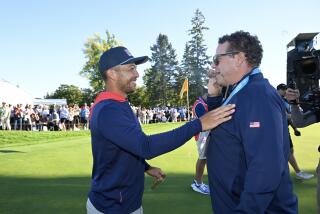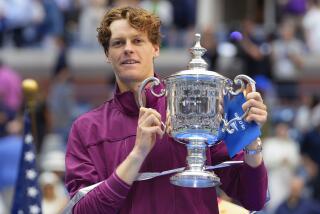U.S. Open Tennis Championships : Evert and Foe: 19 Years and Worlds Apart
- Share via
NEW YORK — For Chris Evert, her final U.S. Open comes to this: she must beat a player 19 years younger, a rising star and a possible heir to her legacy.
This changing of the guard will be done in the nursery.
“Chris is playing someone old enough that she could be her mother,” Martina Navratilova said.
Evert, 34, scored her 100th U.S. Open victory Friday, 6-2, 6-4, over Patricia Tarabini of Argentina to set up a fourth-round match with 15-year-old Monica Seles, the two-fisted slugger from Yugoslavia who grunts like Jimmy Connors and chuckles like Woody Woodpecker.
Sunday, women’s tennis will find out if she can replace somebody such as Chris Evert.
It won’t be an easy task. Evert has won 1,302 times with 18 Grand Slam titles among them. The U.S. Open, a championship which she has claimed six times, will be her final major tournament, and for that reason, Evert is a sentimental favorite.
Evert dines with Donald Trump, favors limousines as her preferred method of street travel and wears a diamond ring the size of Manhattan. This is an image worthy of Evert, the grand dame of tennis, and one with which she feels most comfortable.
Seles enjoys a different image. She wears a blue-jean jacket as she walks around the U.S. Open grounds in the early-morning hours before her match. In the players’ lounge, Seles puts on earphones and listens to her rock music tapes.
She probably isn’t that much different than Evert was in 1971 as a 16-year-old playing in her first U.S. Open.
“It reminds me of my first year at Forest Hills . . . It is a great time for Monica now,” Evert said. “She has no pressure because she will never go down in the rankings. She will grow and get better.
“The shoe is on the other foot because I was once in her position, playing Billie Jean King and Margaret Court,” Evert said. “The roles are reversed now.”
Seles hits hard enough to flatten the balls and grunts loudly with nearly every shot.
“She hits it as hard as she can, and most of the time it goes in,” Navratilova said.
Seles has already played Evert twice, losing once in the Virginia Slims of Florida and winning in the final at the Virginia Slims of Houston.
But Seles is not eager to be the one playing Evert at such an historic stage.
“It would probably be much easier for me if this wasn’t her last tournament,” Seles said. “I know that she’s won so much here, and whoever will beat her here will be remembered.”
Evert won’t really be through if she loses to Seles, though. She is still planning on playing on the U.S. team in the Federation Cup in October and reserves the right to play in a random tournament or two on a whim.
However, there is no question that this is Evert’s last U.S. Open, where she has reached the quarterfinals in each of her 18 appearances.
Navratilova says Evert is capable of making her 56th Grand Slam event memorable for being something else besides her last.
“You can just bet she is going to do everything she can to win, especially against someone like Seles,” Navratilova said. “She’s going to be tough to beat.”
Navratilova scored a 6-4, 6-0, victory over Sabrina Goles of Czechoslovakia and enters the fourth round having lost only seven games.
The weather was breezy and mostly overcast, and Navratilova found the playing conditions difficult.
“It was just survival time,” said Navratilova, who managed to avoid in swirling winds the same kind of fate that swept away Hana Mandlikova.
The sixteenth-seeded and No. 15-ranked Mandlikova of Australia, was defeated, 6-2, 3-6, 6-1, by 18-year-old Donna Faber of Hilton Head, S.C. Faber, ranked No. 83, turned pro only 10 months ago.
“She’s not that talented, but I think she’s a really hard worker and with hard work you can come long,” Mandlikova said.
Faber will play fifth-seeded Zina Garrison in the fourth round. Navratilova will meet Regina Rajchrtova of Czechoslovakia, and the winner will take on either Manuela Maleeva of Bulgaria or Natalia Zvereva of the Soviet Union in the quarterfinals.
Boris Becker battled breezes and Miloslav Mecir before blowing into the fourth round with a 6-4, 3-6, 6-4, 6-2 victory.
Becker, seeded behind only Ivan Lendl, was baffled briefly by the wind but felt better when he remembered how he came from being down two sets to love to win his second-round match against Derrick Rostagno.
“It’s probably the worst conditions that I have ever had (at the U.S. Open),” Becker said. “It was almost impossible to play normal tennis. That’s why it was a match with many breaks, many strange shots.”
There were 12 service breaks in the windblown match, seven of them by Becker on Mecir’s shaky serve.
Both 11th-seeded Jay Berger and 14th-seeded Aaron Krickstein came from two sets down to win their third-round matches.
Berger defeated Ken Flach, 6-7 (10-12), 4-6, 6-2, 6-3, 6-4, and Krickstein beat Alexander Volkov of the Soviet Union, 3-6, 3-6, 6-4, 6-2, 6-2.
Krickstein, 22, is accustomed to five-set matches in the U.S. Open. This was his eighth, his seventh victory and the fourth time he had won after losing the first two sets.
Afterward, Krickstein was glad it was over.
“I was dead tired,” he said.
There wasn’t much that could upset Krickstein, not even the fact that he’s been left out of stories about young American tennis stars that included Andre Agassi, Michael Chang, Pete Samparas, Jim Courier and Berger.
Krickstein pointed out that he is nine months younger than Berger, who will be 23 in November.
“Everybody must think I’m 28 or something,” Krickstein said.
Also joining the winners in the fourth round were Wednesday night’s giant-killers--Sampras and Paul Haarhuis of the Netherlands.
Sampras followed up his second-round upset of Mats Wilander with a 4-6, 6-4, 6-3, 6-2 victory over Jaime Yzaga of Peru, who had beaten him in last year’s Open.
After knocking off four-time champion John McEnroe in the second round, Haarhuis won his third-round match with Miguel Nido of Puerto Rico, 7-5, 7-6 (7-5), 6-0.
Sampras served nine aces and made only 55% of his first serves, but he was opportunistic, cashing in four of his six break chances.
Next, Haarhuis plays Krickstein and Sampras meets Berger. With McEnroe and Wilander gone, someone from this group is assured of reaching the semifinals and a possible match against Becker.
More to Read
Go beyond the scoreboard
Get the latest on L.A.'s teams in the daily Sports Report newsletter.
You may occasionally receive promotional content from the Los Angeles Times.










